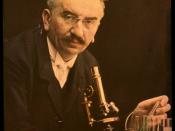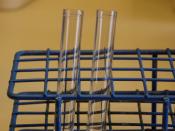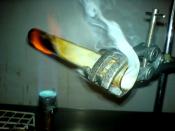Testing Food Substances for the Presence of Lipids
Aim:
To establish which food substances contain lipids.
Hypothesis:
1. All diary products will contain lipids.
2. All animal tissue will contain lipids.
3. All plant storage organ products, i.e. seeds, will contain lipids.
Introduction:
Lipids are insoluble in water but soluble in organic solvents. Ethanol is an example of an organic polar solvent which will dissolve lipids to a limited extent. However ethanol is miscible with water so when a solution of lipid and ethanol is added to water the ethanol will combine preferentially to the water, leaving the ethanol to form tiny globules in the water. These globules then form a white emulsion.
Sudan III is a dye which binds preferentially to lipids and will stain them red. When lipids are in an aqueous suspension, the dye will colour them red whilst the water remains a light pink.
Method:
The presence of lipids was tested for in various food substances using the ethanol emulsion test, the grease spot test and the Sudan III test.
1. The liquid substances were all placed in 250cm3 beakers; vegetable oil, full fat milk, egg yolk and egg white. The watsits were ground using a mortar and pestle. All of the other substances were placed into petri dishes; the butter, margarine and lard were placed in directly; the bacon and cheese were thinly sliced using a scalpel and white tile and the chocolate was grated.
2. A boiling water bath should then be set up for use in the Sudan III test; A beaker containing 250cm3 of water should be set up on a tripod and gauze over a Bunsen burner. Once lit the air hole on the Bunsen burner should be opened so that it burns with a blue flame.
The Grease Spot Test...


